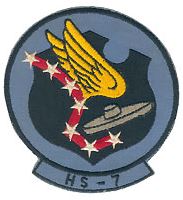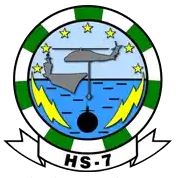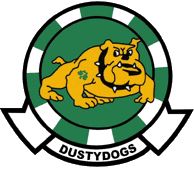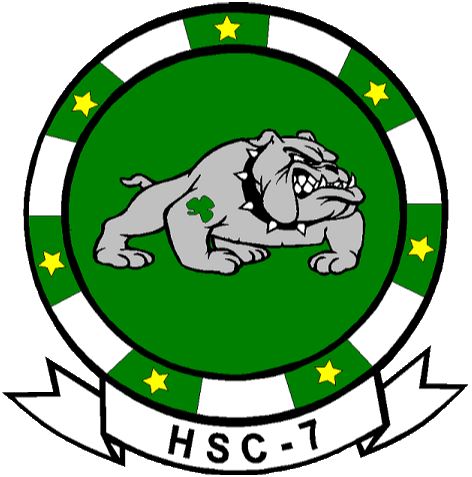COmmand History




Helicopter Anti-Submarine Squadron (HS) 7 was originally established in April 1956 at Naval Air Station Norfolk, Virginia for the mission of harbor defense. The squadron, originally known as the “Big Dippers,” was later assigned the role of Anti-Submarine Warfare (ASW) in support of fleet units. HS-7 served onboard the USS Valley Forge (CV 45) and the USS Randolph (CV 15) while flying the Sikorsky H04S-3 Sea Horse, and later the HSS-1 Sea Bat helicopter, which was redesignated the SH-34 Seabat, in compliance with the United States Tri-Service aircraft designation system. One of the “Big Dippers” most notable missions was the recovery of astronaut Gus Grissom on July 12, 1961 after his spacecraft, the Liberty Bell 7, began to sink after splashdown. In 1965, The “Big Dippers” transitioned briefly to the SH-3A Sea King helicopter, prior to their eventual decommission. The squadron was decommissioned on May 31, 1966, but later re-established at Naval Air Station Quonset Point, Rhode Island, on December 15, 1969, where they would deploy aboard the USS Saratoga (CV 60), equipped with the Sikorsky SH-3D Sea King.
During a respite between cruises in 1970-71, the squadron held a naming contest, resulting in the “Big Dippers” becoming the “Shamrocks.” In 1973, HS-7 joined Carrier Air Wing (CVW) 3, changed homeports to Naval Air Station Jacksonville, Florida, and transitioned to the venerable SH-3H Sea King helicopter. From 1981 to 1993, the Shamrocks deployed numerous times on board the USS John F. Kennedy (CV 67), including deployments in support of Operations Desert Shield and Desert Storm. In December 1993, the Shamrocks and CVW-3 shifted to the USS Dwight D. Eisenhower (CVN 69), affectionately called the “Ike”, and in 1994, HS-7 became the first HS squadron on the East Coast to be assigned female Sailors.
In September 1994, HS-7 was tasked to support the Ike and the U.S. Army’s 10th Mountain Division off the coast of Haiti during Operation Uphold Democracy. Later that same year, HS-7 deployed to the Arabian Gulf in support of Operation Southern Watch and in the Adriatic Sea during Operations Deny Flight and Provide Promise.
Upon returning from the Ike in 1995, the Shamrocks transitioned to the Sikorsky SH-60F and HH-60H and adopted the new call sign “Dusty Dogs.” In May 1997, the squadron completed their first deployment flying the new aircraft from USS Theodore Roosevelt (CVN 71) in May 1997. HS-7 went out again from October 1998 to May 1999 on board the USS Enterprise (CVN 65) in support of Operations Desert Fox and Deliberate Forge. The squadron completed the maiden cruise of the USS Harry S. Truman (CVN 75) in 2000 and returned in June 2001. From December 2002 until April 2005, HS-7 deployed twice more aboard the Truman. During the 2003 cruise on board the Truman, HS-7 served in the Mediterranean and Adriatic Seas in support of Operations Northern Watch and Iraqi Freedom.
In September 2005, HS-7, aboard the USS Harry S. Truman, went to the Gulf of Mexico in support of Hurricane Katrina relief efforts. During Joint Task Force Katrina, HS-7 conducted 222 evacuations, 500 rescues, 90 medical evacuations (MEDEVACS), and delivered over 27,000 pounds of food, supplies, and other essential cargo.
From November of 2007 to June 2008, the Dusty Dogs again deployed aboard the USS Harry S. Truman with CVW-3 in support of Operations Iraqi Freedom and Enduring Freedom. From June 2008 to May 2010 the Dusty Dogs met the challenges of an extended work-up cycle, which included eight at-sea periods, two Air Wing trips to Naval Air Station (NAS) Fallon, and four detachments to AUTEC.
In May 2010, HS-7, attached to CVW-3, departed aboard the USS Harry S. Truman for a seven-month deployment to the 5th Fleet area of responsibility. The Dusty Dogs supported Carrier Strike Group (CSG) 10 assets participating in Operations Enduring Freedom and New Dawn while providing the strike group with essential anti-terrorism force protection, logistic, MEDEVAC, and search and rescue (SAR) support. Cruise highlights include the night rescue of eight Iranian mariners in the North Arabian Sea and joint rotary wing training with the Royal Air Force of Oman – a first in the history of U.S. Naval helicopter aviation. In November 2010, after 54 years of excellence in anti-submarine warfare, HS-7 sundowned their ASW mission when they went “ball dry” for the last time.
On April 15, 2011, HS-7 was re-designated Helicopter Sea Combat Squadron (HSC) 7. From there, the squadron moved to Norfolk, Virginia, and successfully completed their transition to the MH-60S. At the end of 2012, HSC-7 began the first of their deployment work ups in the MH-60S.
From July 2013 to April 2014, HSC-7 launched its inaugural MH-60S deployment in support of Operation Enduring Freedom. During this deployment, the Dusty Dogs received outstanding news that one of their crews being selected as Naval Helicopter Association (NHA) East Coast deployed Aircrew of the Year who successfully MEDEVACed a civilian merchant from a foreign vessel, flying the patient into Muscat, Oman. Following deployment, HSC-7 helped to develop the launch and recovery procedures for the LAU-61A/C rocket pod system into and out of Naval Station Norfolk.
2015-2016 was another year filled with work ups for the next upcoming deployment. From June 2016 to December 2016 HSC-7 deployed aboard the USS Dwight D. Eisenhower (CVN 69) in support of Operation Inherent Resolve. Over 2,800 flight hours were flown on deployment with a detachment aboard the USNS Arctic, transferring more than three and a half million pounds of cargo.
From August to November of 2017, the Dusty Dogs flew over 235 flight hours during their Defense Support to Civil Authority (DSCA) operations following Hurricanes Harvey, Irma, and Maria in Texas and Puerto Rico. During the relief operations, over 200 sorties were flown accounting for the transportation of 1566 passengers, 966,000 lbs. of cargo, and 850 flying hours.
From the start of 2018 to June 2019, HSC-7 conducted multiple detachments ranging from operations with special forces to carrier qualifications for aircraft carriers including USS Harry S. Truman, USS Abraham Lincoln, and USS Dwight D. Eisenhower.
July of 2019 HSC-7 began pre-deployment workups with multiple training detachments testing the squadron’s readiness. Helicopter Advanced Readiness Program (HARP), Tailored Ship’s Training Availability (TSTA), and Air Wing Fallon highlight the training that took place. Composite Training Unit Exercise (COMPTUEX) was the final test in January of 2020 that saw the Dusty Dogs off on their 2020 Deployment, which spanned 6 months, from February to August. The 2020 deployment proved to be historic for HSC-7. With a record breaking 206 days at sea without a port call, the Dusty Dogs sailed to the 6th and 5th Fleet AORs, sustaining operations longer than any other squadron in modern history. With six aircraft aboard the USS Dwight D. Eisenhower and a supply detachment of two helicopters embarked aboard the supply ship USS Robert E. Peary, HSC-7 flew 3,190 hours, 882 sorties, executed a 90% sortie completion rate, and moved 102 million pounds of cargo for the fleet.
After a short four months at home, HSC-7 had a quick turnaround, and embarked again, from January to July 2021, another seven-month deployment to the 5th and 6th fleet AORs, supporting CVW-3 during Operations Inherent Resolve and Freedom Sentinel.
2022-2023 was another busy time for the squadron, completing numerous carrier qualification detachments on the USS Dwight D. Eisenhower (CVN 69) and the USS George H.W. Bush (CVN 77), as well as successfully executing HARP at Naval Air Station Key West in September 2022, and integrating with the other CVW-3 squadrons at Air Wing Fallon at NAS Fallon, Nevada, from March-May of 2023 as work ups continue for the upcoming deployment.